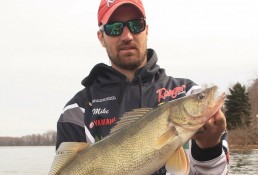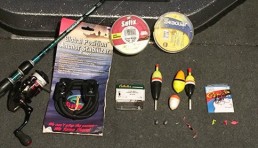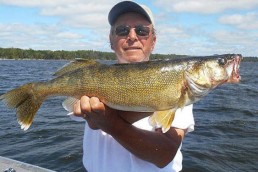Precise Depth and Presentation Control: Bobbers for Big Walleyes
SHARE THIS POST
Using a slip bobber or “corking” is an often-overlooked technique that produces not only numbers of fish, but also large fish. Fishing using a slip bobber is not only fun, but also extremely productive. It allows the angler to accurately present bait at a targeted depth.
The advantage of fishing with this technique is the ability to adjust the depth very quickly and easily by sliding up or down the bobber stop on the line. Bobbers are able to present bait for a long period of time within the strike zone.
Slip bobber fishing is commonly used when fishing panfish, but not as common as fishing for walleyes. Rigging, trolling and jig fishing are more commonly used. There are a number of scenarios that work great with slip bobbers. A few of those times are when fish are bunched up on structure such as rocks, weedlines and timber and when fish are suspended and active.
Here are a few examples when bobbers outshine other techniques:
- When fish are negative or neutral, bobbers will often produce when other techniques won’t.
- In heavy “snag” areas, such as timber, bobbers can present the bait within the wood and prevent time-consuming, costly snags.
- Positioning on weedlines, bobbers hold the bait on the edge.
- Rock reefs are often some of the best areas to use a bobber.
When talking tackle it doesn’t take a lot of money to have a great setup. Basic tools you need are egg sinkers and/or split shots, barrel swivels, bobber stops, beads, hooks and/or jigs. Rigging is simple, first with the bobber stop then a bead next the all-important bobber.
There are many types to choose, from Styrofoam to natural cork. I prefer the Thill Pro Series with the brass grommets. It prevents the line from cutting into the bobber and allows it to slide freely.
Another great option is the Lindy Wobble Bobber, which creates a little action to your bait with very little waves, sometimes making all the difference. During night fishing, the Thill Splash Bright is my go-to bobber. It lights up when wet and lasts for many hours. Then try sliding an egg sinker, usually 1/4 ounce, above the number 10 barrel swivel. The barrel swivel prevents line twist and damage to the line through its crimp-on-type weights. Follow this with a 16- to 20-inch leader of florocarbon to the hook.
Are you enjoying this post?
You can be among the first to get the latest info on where to go, what to use and how to use it!
There are many options for the “business” end. Simple octopus hooks in size number 6 or 8 work great for leeches, while number 2 or 4 are better for minnows. Sometimes adding a simple bead or 3/32-ounce jig head will outproduce plain hooks.
When it comes to rods, I prefer a 7-foot medium-fast action like a St. Croix Avid or Tournament series. Many others prefer even longer rods, like a 10-foot-plus option. The reason for such a long rod is the ability to pick up the slack in your line. By using fly fisherman’s wax like Mucilin on your monofilament, it makes it float and easy to pick up off the water with a shorter rod. A 7-foot rod works well and stores easily in my Ranger boat. Use 6- or 8-pound test for your line.
Once you’re all rigged up, positioning your boat on any given structure is number one for being successful. Anchoring is the most common technique when bobber fishing. With the new technology in trolling motors with the ability to hold a position, many use that as an anchor. However, in regards to successful position anchoring in “corking,” the GPS anchor feature doesn’t work well, as the boat will always be facing the wind. When fishing with bobbers, you are waiting a period of time in one place and it is unnecessary to burn battery power to hold a position when an anchor is far superior. In windy conditions I use a GPAS Anchor Stabilizer on my anchor lines to prevent dragging my anchor; it’s a shock absorber for your anchor line.
I prefer to anchor sideways, “position anchoring,” to the structure, allowing multiple anglers to fish out one side. Another key is with the wind at your back, it is easier to take in slack for good hook-sets. Position anchoring to the structure requires two anchors positioned at each end of the boat.
Another less common, but overlooked technique, is “power corking.” This is extremely effective, consisting of driving around and marking fish with your electronics then dropping your bobber over the stern by the transducer right on top of the fish. Power corking works best in warmer water when fish are active. Many times during warmer water conditions, the walleyes suspended here are the most active fish and positioning your bait at their level is hard to resist. Slip bobber fishing is also great with a novice angler and children, as it requires less skill and casting ability and gives them something to watch or participate to in. The excitement when a bobber goes down and the easy telltale sign of a bite make it easy for family outings.
Big walleyes like to look at the bait in their face for a long time. While fishing on rock reefs in Canada in the summer I have boated hundreds of fish over 28 inches when nothing else produced. Many anglers have also found bobbers to be effective on the same type of structure on Mille Lacs, Leech and Lake of the Woods.
The next time you’re on the water, give slip bobber fishing a chance and see for yourself how effective it is.
MWO
SHARE THIS POST
Did you enjoy this post?
You can be among the first to get the latest info on where to go, what to use and how to use it!
Mike Klein
MidWest Outdoors works with more than 200 outdoor experts each year, who contribute articles based on their areas of expertise. MidWest Outdoors magazine offers more fishing and hunting articles than any other publication!




